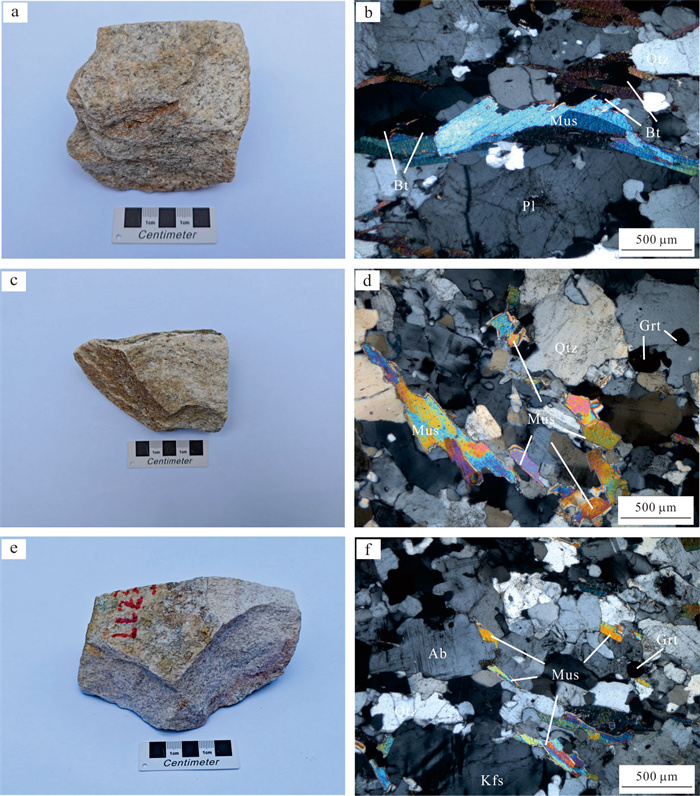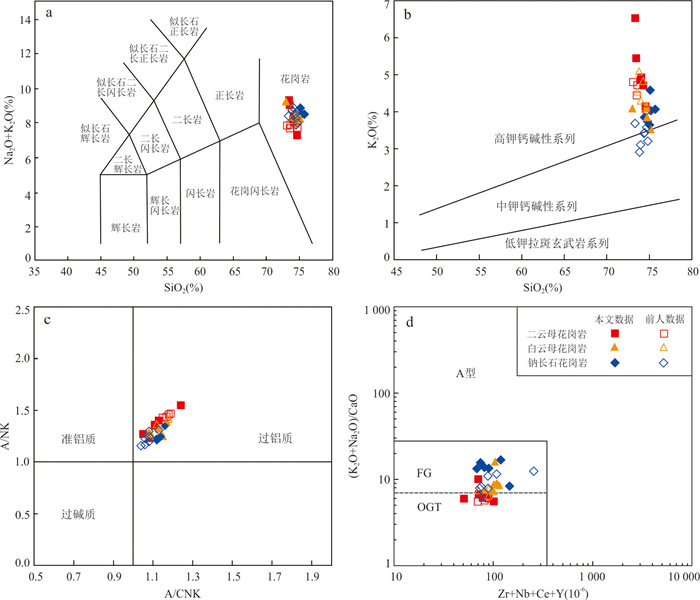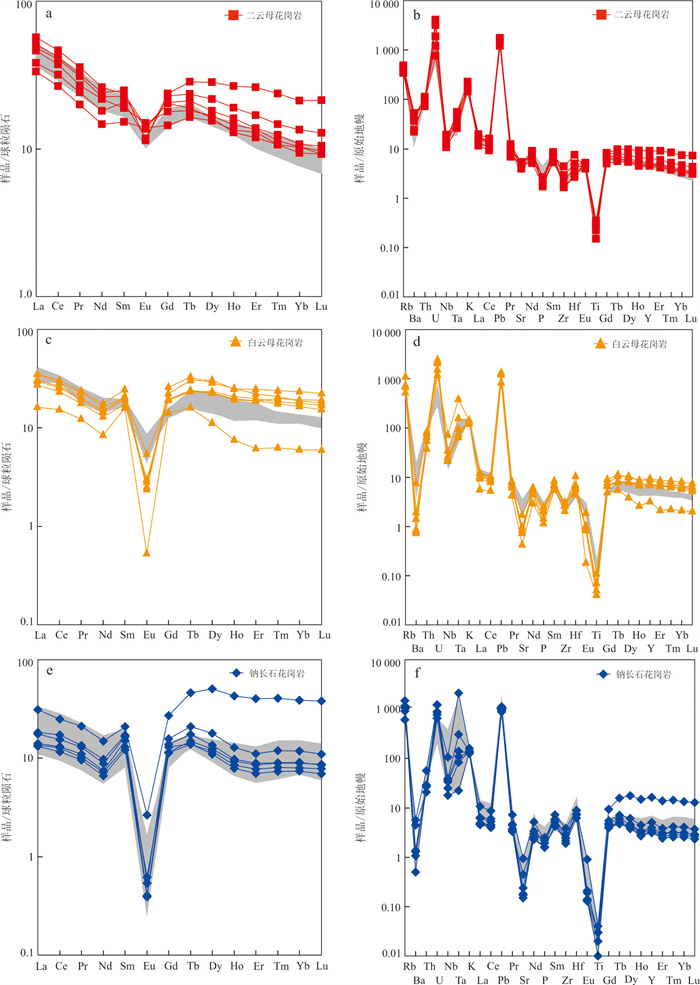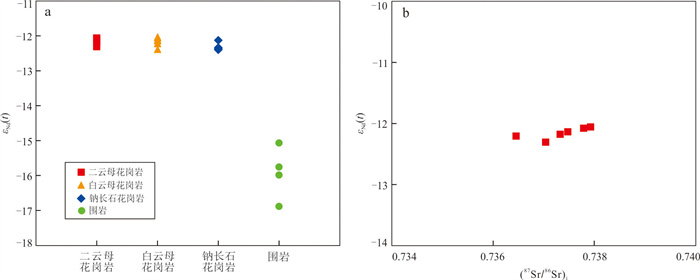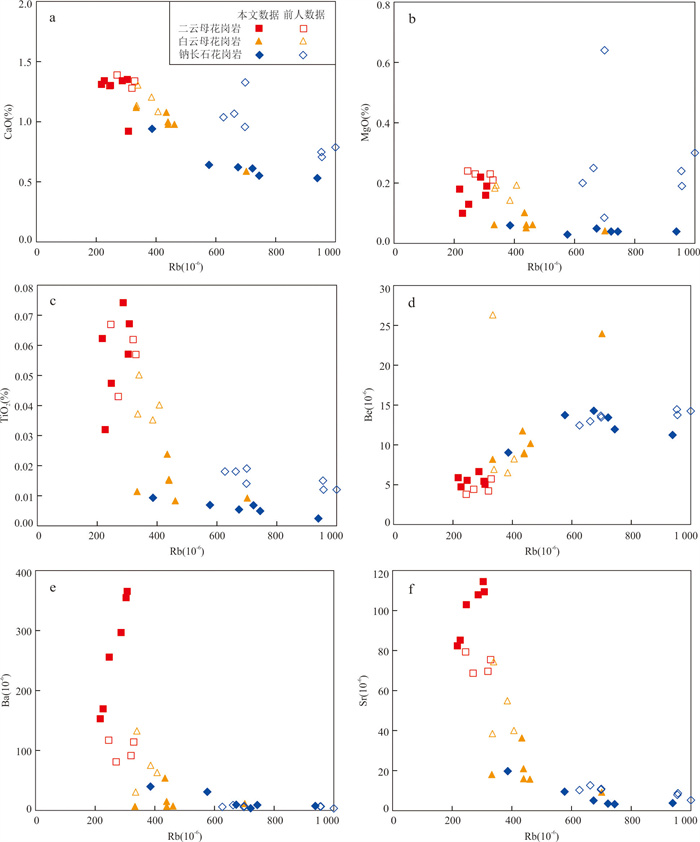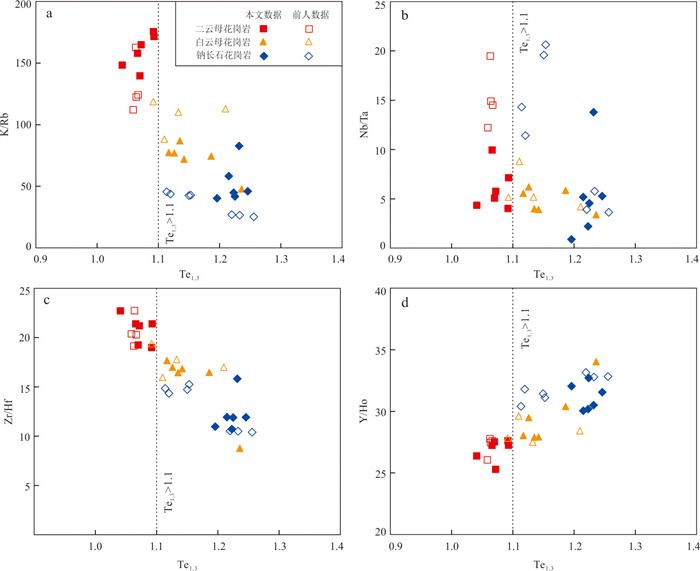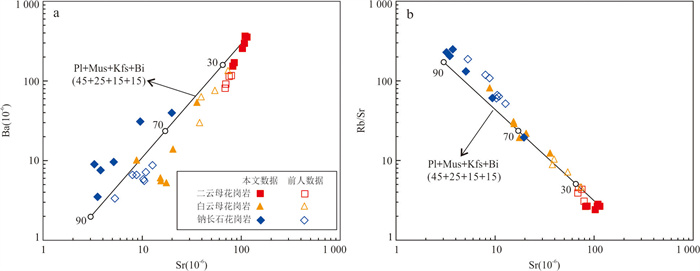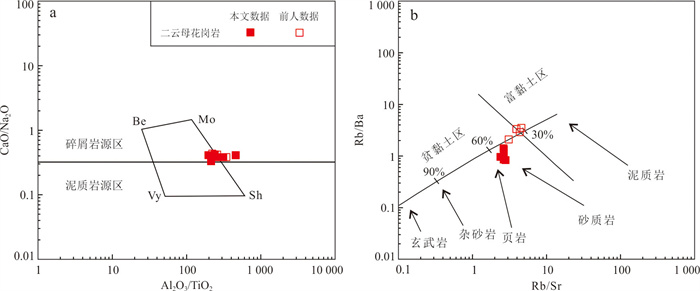Petrogenesis of Lalong Leucogranites in Eastern Himalayan Orogenic Belt and Relationship with South Tibetan Detachment System
-
摘要:
作为碰撞造山带的产物,淡色花岗岩不仅与稀有金属成矿密切相关,还对造山过程及高原隆升机制有着重要指示意义.关于淡色花岗岩的成因,目前尚存很大争议.早期研究认为淡色花岗岩是原地变沉积岩经低程度部分熔融的产物,但近年来,越来越多的学者指出,淡色花岗岩可能是一种高分异花岗岩,是岩浆高度结晶分异的产物.为探究淡色花岗岩的成因,对喜马拉雅造山带东段的拉隆淡色花岗岩及它们的围岩(板岩与大理岩)进行了独居石U-Th-Pb定年以及全岩主微量元素和Sr-Nd同位素分析.拉隆淡色花岗岩位于拉隆穹窿的核部,从内到外,依次出露二云母花岗岩、白云母花岗岩和钠长石花岗岩.定年结果表明,这三种淡色花岗岩具有相近的侵位时代(22~23 Ma).淡色花岗岩总体显示高硅(SiO2=73.0%~75.7%)、高钾(K2O=3.50%~6.53%)、低镁(MgO=0.03%~0.22%)和过铝质(A/CNK=1.05~1.24)的主量元素特征.从二云母花岗岩到白云母花岗岩到钠长石花岗岩,Eu的负异常逐渐加剧,Rb、Rb/Sr和Y/Ho逐渐升高而Sr、Ba、K/Rb和Zr/Hf逐渐降低.此外,这些淡色花岗岩具有相似的全岩Sr-Nd同位素组成:(87Sr/86Sr)i=0.736 456~0.737 929,εNd(t)=-12.4~-12.1,但明显亏损于围岩的Nd同位素组成(εNd(t)=-16.9~-15.1).二云母花岗岩具有与高喜马拉雅结晶岩系一致的Sr-Nd同位素组成,高的CaO/Na2O(0.33~0.42)和Al2O3/TiO2(197~459)比值指示其源区以碎屑岩为主.上述的野外空间分布规律和数据结果说明,拉隆淡色花岗岩可能起源于高喜马拉雅结晶岩系变质杂砂岩的白云母脱水熔融,并经过了一定程度的分离结晶,而不是原地变沉积岩部分熔融的产物.微量元素的瑞利分馏模拟计算结果也证明,以二云母花岗岩为初始熔体时可以经历~70%和~90%程度的分离结晶形成白云母花岗岩和钠长石花岗岩.考虑到藏南拆离系和拉隆淡色花岗岩在时间上的重叠关系,藏南拆离系可能通过减压的方式触发了淡色花岗岩源区的部分熔融并为淡色花岗岩的流动分异提供了空间.
Abstract:As a product of collision orogenic belt, leucogranites are not only closely related to rare metal mineralization, but also have great significance to orogenesis and plateau uplift mechanism. The petrogenesis of leucogranites is still controversial. Earlier studies suggested that leucogranites were generated by low-degree in-situ partial melting of metasedimentary rocks, but in recent years, more scholars have pointed out that they may be highly fractionated granites, and the magma had undergone an intensive fractional crystallization. In order to explore the petrogenesis of leucogranites, we collected Lalong leucogranites and their sedimentary surrounding rocks (marbles and slates) in the eastern Himalayan orogenic belt to analyze the major and trace elements, Sr-Nd isotopes and monazite U-Th-Pb dating. Lalong leucogranites are located in the core of the Lalong dome, where two-mica granites, muscovite granites and albite granites are exposed in turn from inside to outside. The dating results show that these three leucogranites have similar emplacement ages (22-23 Ma). Generally, the leucogranites show high SiO2 (73.0%-75.7%), high K2O (3.50%-6.53%), low MgO (0.03%-0.22%) and peraluminum (A/CNK=1.05-1.24). From two-mica granites through muscovite granites to albite granites, the negative Eu anomalies became intensified, Rb, Rb/Sr and Y/Ho gradually increased, while Sr, Ba, K/Rb and Zr/Hf gradually decreased. In addition, these leucogranites have consistent Sr-Nd isotopic compositions: (87Sr/86Sr)i=0.736 456-0.737 929, εNd(t)=-12.4 to -12.1, which are more depleted than that of the surrounding rocks (εNd(t)=-16.9 to -15.1). Two-mica granites have consistent Sr-Nd isotopic compositions with the higher Himalayan crystallines, the high CaO/Na2O ratio values (0.33-0.42) and Al2O3/TiO2 ratio values (197-459), indicating that their source region is dominated by clastic rocks. The spatial distribution characteristics in the field and data results show that the Lalong leucogranites may have originated from muscovite dehydration melting of metagreywacks in higher Himalayan crystallines, which had undergone certain degree of fractional crystallization rather than generated by in-situ partial melting of metasedimentary rocks. The trace element Rayleigh fractionation modeling results also prove that when two-mica granite is used as the initial melt, it could generate muscovite granites and albite granites after fractional crystallization of about 70% and about 90%, respectively. Considering the overlapping relationship between the South Tibetan Detachment System and the Lalong leucogranites, this paper considers that the South Tibetan Detachment System may have triggered partial melting of the leucogranites source region by decompression and provided space for the flowage differentiation of the leucogranites.
-
图 1 (a)喜马拉雅造山带地质简图(据Fu et al., 2023修改);(b)拉隆穹窿地质简图(据付建刚等,2020修改)
Fig. 1. (a) Simplified geologic map of the Himalayan orogen (modified from Fu et al., 2023); (b) simplified geologic map of the Lalong dome (modified from Fu et al., 2020)
图 5 拉隆淡色花岗岩分类图解
a. TAS分类图解(底图据Middlemost,1994);b. K2O-SiO2分类图解(底图据Peccerillo and Taylor,1976);c. A/NK-A/CNK分类图解(底图据Maniar and Piccoli,1989);d.(K2O+Na2O)/CaO-(Zr+Nb+Ce+Y)图解(底图据Whalen et al., 1987),FG.分异的I、S和M型花岗岩,OGT.未分异的I、S和M型花岗岩. 前人数据引自Fu et al.(2023)
Fig. 5. Classification diagrams for leucogranites from the Lalong dome
图 6 拉隆淡色花岗岩稀土元素球粒陨石标准化配分图(a、c、e)和微量元素原始地幔标准化配分图(b、d、f)
标准化值据Sun and McDonough(1989);阴影区数据引自Fu et al.(2023)
Fig. 6. Chondrite-normalized REE patterns (a, c, e) and primitive mantle-normalized trace element patterns (b, d, f) for leucogranites in the Lalong dome
图 8 拉隆淡色花岗岩Harker图解(前人数据引自Fu et al., 2023)
Fig. 8. Harker variation diagrams for the major and trace elements of the Lalong leucogranites (previous data after Fu et al., 2023)
图 9 拉隆淡色花岗岩的K/Rb、Nb/Ta、Zr/Hf和Y/Ho比值以及与Te1, 3相关关系特征图解(前人数据引自Fu et al., 2023)
Fig. 9. Variation diagrams of K/Rb, Nb/Ta, Zr/Hf and Y/Ho vs. Te1, 3 for the Lalong leucogranites (previous data after Fu et al., 2023)
图 10 拉隆淡色花岗岩的Ba和Rb/Sr比值以及与Sr相关关系图解
长石分配系数据Rollinson,1993;云母分配系数据Icenhower and London,1995;前人数据引自Fu et al., 2023
Fig. 10. Variation diagrams of Ba and Rb/Sr vs. Sr for the Lalong leucogranites
图 11 拉隆淡色花岗岩源区判别图解(底图据Sylvester, 1998; 前人数据引自Fu et al., 2023)
Fig. 11. Source zone discrimination diagrams of leucogranites from the Lalong dome (base map after Sylvester, 1998; previous data after Fu et al., 2023)
表 1 拉隆淡色花岗岩独居石LA-ICP-MS U-Th-Pb年龄分析结果
Table 1. Monazite U-Th-Pb isotopic data obtained by LA-ICP-MS for leucogranites from the Lalong dome
测点号 同位素比值及误差 年龄及误差(Ma) 207Pb/206Pb 2σ 207Pb/235U 2σ 206Pb/238U 2σ 208Pb/232Th 2σ 206Pb/238U 2σ 208Pb/232Th 2σ 二云母花岗岩,样品LL23-01-1,208Pb/232Th加权平均年龄(22.8±0.2) Ma,MSWD=1.9,n=24 LL23-01-1-01 0.057 59 0.003 14 0.030 55 0.001 67 0.003 85 0.000 12 0.001 09 0.000 03 24.8 0.8 22.1 0.7 LL23-01-1-02 0.061 23 0.003 21 0.031 09 0.001 64 0.003 68 0.000 12 0.001 09 0.000 03 23.7 0.8 22.0 0.7 LL23-01-1-03 0.064 34 0.003 65 0.034 38 0.001 92 0.003 88 0.000 12 0.001 10 0.000 03 24.9 0.8 22.3 0.7 LL23-01-1-04 0.068 85 0.003 47 0.037 65 0.001 96 0.003 97 0.000 13 0.001 10 0.000 03 25.5 0.8 22.2 0.7 LL23-01-1-05 0.062 05 0.003 30 0.032 46 0.001 74 0.003 80 0.000 12 0.001 11 0.000 03 24.4 0.8 22.5 0.7 LL23-01-1-06 0.057 62 0.003 10 0.027 49 0.001 48 0.003 46 0.000 11 0.001 10 0.000 03 22.3 0.7 22.2 0.7 LL23-01-1-07 0.061 71 0.003 15 0.032 36 0.001 69 0.003 81 0.000 12 0.001 11 0.000 03 24.5 0.8 22.4 0.7 LL23-01-1-08 0.063 35 0.003 63 0.033 96 0.001 91 0.003 89 0.000 13 0.001 12 0.000 03 25.0 0.8 22.6 0.7 LL23-01-1-09 0.060 41 0.003 20 0.031 93 0.00170 0.003 84 0.000 12 0.001 10 0.000 03 24.7 0.8 22.3 0.7 LL23-01-1-10 0.063 30 0.003 39 0.032 45 0.001 75 0.003 72 0.000 12 0.001 12 0.000 04 23.9 0.8 22.6 0.7 LL23-01-1-11 0.064 95 0.003 20 0.032 81 0.001 68 0.003 67 0.000 12 0.001 11 0.000 03 23.6 0.8 22.3 0.7 LL23-01-1-12 0.056 73 0.002 95 0.031 29 0.001 67 0.004 00 0.000 13 0.001 16 0.000 04 25.8 0.9 23.3 0.7 LL23-01-1-13 0.060 44 0.002 91 0.031 60 0.001 59 0.003 79 0.000 12 0.001 14 0.000 04 24.4 0.8 23.1 0.7 LL23-01-1-14 0.057 59 0.002 82 0.030 10 0.001 53 0.003 79 0.000 12 0.001 16 0.000 04 24.4 0.8 23.4 0.7 LL23-01-1-15 0.060 60 0.003 11 0.031 69 0.001 67 0.003 79 0.000 12 0.001 15 0.000 04 24.4 0.8 23.3 0.7 LL23-01-1-16 0.059 81 0.002 70 0.030 94 0.001 50 0.003 75 0.000 12 0.001 15 0.000 04 24.2 0.8 23.2 0.7 LL23-01-1-17 0.060 15 0.003 53 0.032 69 0.001 88 0.003 94 0.000 13 0.001 16 0.000 04 25.4 0.8 23.4 0.7 LL23-01-1-18 0.073 71 0.003 80 0.036 48 0.001 93 0.003 59 0.000 12 0.001 12 0.000 03 23.1 0.7 22.6 0.7 LL23-01-1-19 0.060 26 0.003 11 0.029 90 0.001 58 0.003 60 0.000 12 0.001 12 0.000 03 23.2 0.7 22.7 0.7 LL23-01-1-20 0.058 12 0.002 92 0.030 05 0.001 56 0.003 75 0.000 12 0.001 14 0.000 04 24.1 0.8 22.9 0.7 LL23-01-1-21 0.059 91 0.002 99 0.030 35 0.001 57 0.003 68 0.000 12 0.001 15 0.000 04 23.7 0.8 23.2 0.7 LL23-01-1-22 0.058 35 0.002 93 0.028 71 0.001 49 0.003 57 0.000 11 0.001 13 0.000 03 23.0 0.7 22.9 0.7 LL23-01-1-23 0.055 80 0.002 94 0.028 54 0.001 54 0.003 71 0.000 12 0.001 15 0.000 04 23.9 0.8 23.2 0.7 LL23-01-1-24 0.057 82 0.002 85 0.029 93 0.001 55 0.003 76 0.000 12 0.001 17 0.000 04 24.2 0.8 23.7 0.7 白云母花岗岩,样品LL23-03-1,208Pb/232Th加权平均年龄(23.5±0.2) Ma,MSWD=1.7,n=24 LL23-03-1-01 0.051 99 0.002 01 0.024 21 0.001 06 0.003 38 0.000 10 0.001 09 0.000 03 21.7 0.7 22.1 0.7 LL23-03-1-02 0.054 64 0.001 74 0.026 52 0.001 07 0.003 52 0.000 11 0.001 14 0.000 03 22.7 0.7 22.9 0.7 LL23-03-1-03 0.060 46 0.002 14 0.029 61 0.001 25 0.003 55 0.000 11 0.001 17 0.000 04 22.9 0.7 23.7 0.7 LL23-03-1-04 0.062 01 0.002 45 0.030 73 0.001 37 0.003 60 0.000 11 0.001 18 0.000 04 23.1 0.7 23.8 0.7 LL23-03-1-05 0.052 75 0.001 62 0.025 41 0.001 01 0.003 49 0.000 11 0.001 16 0.000 04 22.5 0.7 23.4 0.7 LL23-03-1-06 0.050 12 0.001 68 0.024 46 0.001 02 0.003 54 0.000 11 0.001 16 0.000 04 22.8 0.7 23.5 0.7 LL23-03-1-07 0.058 11 0.002 35 0.028 53 0.001 30 0.003 56 0.000 11 0.001 18 0.000 04 22.9 0.7 23.7 0.8 LL23-03-1-08 0.054 94 0.001 75 0.027 22 0.001 10 0.003 59 0.000 11 0.001 17 0.000 04 23.1 0.7 23.7 0.7 LL23-03-1-09 0.054 29 0.002 08 0.026 33 0.001 16 0.003 52 0.000 11 0.001 16 0.000 04 22.6 0.7 23.5 0.7 LL23-03-1-10 0.055 00 0.002 10 0.026 87 0.001 18 0.003 54 0.000 11 0.001 15 0.000 04 22.8 0.7 23.3 0.7 LL23-03-1-11 0.058 12 0.002 02 0.028 56 0.001 20 0.003 57 0.000 11 0.001 15 0.000 04 22.9 0.7 23.3 0.7 LL23-03-1-12 0.055 14 0.002 13 0.026 65 0.001 17 0.003 51 0.000 11 0.001 18 0.000 04 22.6 0.7 23.8 0.7 LL23-03-1-13 0.053 61 0.001 70 0.025 25 0.001 01 0.003 42 0.000 11 0.001 13 0.000 04 22.0 0.7 22.8 0.7 LL23-03-1-14 0.052 83 0.001 79 0.025 10 0.001 04 0.003 45 0.000 11 0.001 15 0.000 04 22.2 0.7 23.2 0.7 LL23-03-1-15 0.062 16 0.002 41 0.030 13 0.001 34 0.003 52 0.000 11 0.001 15 0.000 04 22.6 0.7 23.3 0.7 LL23-03-1-16 0.052 85 0.001 61 0.025 30 0.001 00 0.003 47 0.000 11 0.001 13 0.000 04 22.4 0.7 22.8 0.7 LL23-03-1-17 0.058 78 0.002 33 0.027 69 0.001 24 0.003 42 0.000 11 0.001 16 0.000 04 22.0 0.7 23.5 0.7 LL23-03-1-18 0.056 21 0.001 54 0.026 78 0.001 02 0.003 46 0.000 11 0.001 18 0.000 04 22.2 0.7 23.9 0.7 LL23-03-1-19 0.052 34 0.001 47 0.024 85 0.000 95 0.003 45 0.000 11 0.001 19 0.000 04 22.2 0.7 24.0 0.7 LL23-03-1-20 0.053 07 0.001 91 0.025 78 0.001 10 0.003 53 0.000 11 0.001 19 0.000 04 22.7 0.7 24.1 0.7 LL23-03-1-21 0.063 26 0.002 24 0.031 48 0.001 33 0.003 61 0.000 11 0.001 18 0.000 04 23.2 0.7 23.8 0.7 LL23-03-1-22 0.059 30 0.002 29 0.028 84 0.001 28 0.003 53 0.000 11 0.001 16 0.000 04 22.7 0.7 23.4 0.7 LL23-03-1-23 0.052 91 0.001 79 0.025 08 0.001 04 0.003 44 0.000 11 0.001 19 0.000 04 22.1 0.7 24.0 0.7 LL23-03-1-24 0.054 89 0.002 37 0.026 78 0.001 26 0.003 54 0.000 11 0.001 19 0.000 04 22.8 0.7 24.0 0.7 钠长石花岗岩,样品LL23-02-6,208Pb/232Th加权平均年龄(21.9±0.2) Ma,MSWD=1.9,n=23 LL23-02-6-01 0.069 02 0.003 33 0.032 46 0.001 59 0.003 41 0.000 11 0.001 08 0.000 01 22.0 0.7 21.7 0.7 LL23-02-6-02 0.080 20 0.004 97 0.040 35 0.002 33 0.003 65 0.000 12 0.001 08 0.000 01 23.5 0.8 21.8 0.7 LL23-02-6-03 0.083 32 0.005 14 0.041 20 0.002 39 0.003 59 0.000 12 0.001 06 0.000 01 23.1 0.8 21.4 0.7 LL23-02-6-04 0.060 98 0.003 11 0.027 75 0.001 40 0.003 30 0.000 10 0.001 05 0.000 01 21.3 0.7 21.3 0.7 LL23-02-6-05 0.070 91 0.003 68 0.039 38 0.002 10 0.004 03 0.000 14 0.001 06 0.000 01 25.9 0.9 21.4 0.7 LL23-02-6-06 0.069 23 0.003 70 0.031 29 0.001 63 0.003 28 0.000 11 0.001 07 0.000 01 21.1 0.7 21.6 0.7 LL23-02-6-07 0.078 84 0.004 41 0.039 16 0.002 12 0.003 60 0.000 12 0.001 10 0.000 01 23.2 0.8 22.1 0.7 LL23-02-6-08 0.070 04 0.003 80 0.033 51 0.001 77 0.003 47 0.000 11 0.001 09 0.000 01 22.3 0.7 21.9 0.7 LL23-02-6-09 0.079 64 0.003 63 0.037 97 0.001 80 0.003 46 0.000 11 0.001 09 0.000 01 22.3 0.7 21.9 0.7 LL23-02-6-10 0.078 48 0.004 84 0.037 94 0.002 19 0.003 51 0.000 11 0.001 04 0.000 01 22.6 0.7 21.0 0.7 LL23-02-6-11 0.074 04 0.004 16 0.035 95 0.001 95 0.003 52 0.000 11 0.001 09 0.000 01 22.7 0.7 22.1 0.7 LL23-02-6-12 0.071 44 0.003 91 0.035 05 0.001 88 0.003 56 0.000 12 0.001 08 0.000 01 22.9 0.7 21.9 0.7 LL23-02-6-13 0.093 03 0.005 56 0.048 24 0.002 74 0.003 76 0.000 12 0.001 13 0.000 01 24.2 0.8 22.8 0.7 LL23-02-6-14 0.076 22 0.003 96 0.036 71 0.001 90 0.003 49 0.000 11 0.001 08 0.000 01 22.5 0.7 21.8 0.7 LL23-02-6-15 0.067 51 0.003 15 0.031 04 0.001 50 0.003 34 0.000 11 0.001 11 0.000 01 21.5 0.7 22.5 0.7 LL23-02-6-16 0.072 34 0.004 23 0.034 15 0.001 91 0.003 43 0.000 11 0.001 13 0.000 01 22.0 0.7 22.9 0.7 LL23-02-6-17 0.073 78 0.003 51 0.033 36 0.001 63 0.003 28 0.000 11 0.001 07 0.000 01 21.1 0.7 21.7 0.7 LL23-02-6-18 0.078 53 0.004 04 0.037 65 0.001 93 0.003 48 0.000 11 0.001 11 0.000 01 22.4 0.7 22.5 0.7 LL23-02-6-19 0.062 84 0.002 30 0.028 01 0.001 18 0.003 23 0.000 10 0.001 07 0.000 01 20.8 0.6 21.6 0.7 LL23-02-6-20 0.084 50 0.005 20 0.042 79 0.002 49 0.003 67 0.000 12 0.001 12 0.000 01 23.6 0.8 22.5 0.7 LL23-02-6-21 0.084 89 0.004 84 0.041 45 0.002 28 0.003 54 0.000 12 0.001 09 0.000 01 22.8 0.7 22.1 0.7 LL23-02-6-22 0.083 34 0.005 36 0.045 03 0.002 69 0.003 92 0.000 13 0.001 08 0.000 01 25.2 0.8 21.8 0.7 LL23-02-6-23 0.083 54 0.004 57 0.042 40 0.002 28 0.003 68 0.000 12 0.001 10 0.000 01 23.7 0.8 22.3 0.7 表 2 瑞利分馏矿物分配系数与模拟数据
Table 2. Mineral partition coefficients and modeling data of Rayleigh fractionation
矿物分配系数 模拟数据 斜长石 钾长石 黑云母 白云母 总分配系数D C0 (10‒6) Rb 0.041 0.34 2.00 1.60 0.77 304.34 Sr 4.40 3.87 0.04 0.05 2.58 114.41 Ba 0.308 6.12 8.00 4.00 3.26 354.89 分离结晶矿物比例(%) 45 15 15 25 注:长石分配系数据Rollinson, 1993; 云母分配系数据Icenhower and London, 1995. -
Ballouard, C., Poujol, M., Boulvais, P., et al., 2016. Nb-Ta Fractionation in Peraluminous Granites: A Marker of the Magmatic-Hydrothermal Transition. Geology, 44(3): 231-234. https://doi.org/10.1130/G37475.1 Bau, M., 1996. Controls on the Fractionation of Isovalent Trace Elements in Magmatic and Aqueous Systems: Evidence from Y/Ho, Zr/Hf, and Lanthanide Tetrad Effect. Contributions to Mineralogy and Petrology, 123(3): 323-333. https://doi.org/10.1007/s004100050159 Burg, J. P., Chen, G. M., 1984. Tectonics and Structural Zonation of Southern Tibet, China. Nature, 311(5983): 219-223. https://doi.org/10.1038/311219a0 Cao, H. W., Li, G. M., Zhang, L. K., et al., 2022. Genesis of Himalayan Leucogranite and Its Potentiality of Rare-Metal Mineralization. Sedimentary Geology and Tethyan Geology, 42(2): 189-211 (in Chinese with English abstract). Chu, Y., Guo, Y. L., Liu, T. J., et al., 2024. South Tibetan Detachment System Activity and Leucogranite Emplacement: Insights from the Shisha Pangma Regions. Acta Petrologica Sinica, 40(5): 1461-1474 (in Chinese with English abstract). Dingwell, D. B., Knoche, R., Webb, S. L., 1993. The Effect of P2O5 on the Viscosity of Haplogranitic Liquid. European Journal of Mineralogy, 5(1): 133-140. https://doi.org/10.1127/ejm/5/1/0133 Dingwell, D. B., Knoche, R., Webb, S. L., et al., 1992. The Effect of B2O3 on the Viscosity of Haplogranitic Liquids. American Mineralogist, 77(5-6): 457-461. Fu, J. G., Li, G. M., Dong, S. L., et al., 2020. Identification and Its Significances of the Lalong Be-Nb-Ta-Bearing Albite Granite in the Northern Himalaya, Tibet. Sedimentary Geology and Tethyan Geology, 40(2): 91-103 (in Chinese with English abstract). Fu, J. G., Li, G. M., Wang, G. H., et al., 2021. Geological Characteristics and Metallogenic Types of Be-Nb-Ta Rare Metals in the Lalong Dome, Southern Tibet, China. Geotectonica et Metallogenia, 45(5): 913-933 (in Chinese with English abstract). Fu, J. G., Li, G. M., Wang, G. H., et al., 2023. Geochemical Evidence for Genesis of Nb-Ta-Be Rare Metal Mineralization in Highly Fractionated Leucogranites at the Lalong Dome, Tethyan Himalaya, China. Minerals, 13(11): 1456. https://doi.org/10.3390/min13111456 Gao, L. E., Zeng, L. S., 2014. Fluxed Melting of Metapelite and the Formation of Miocene High-CaO Two-Mica Granites in the Malashan Gneiss Dome, Southern Tibet. Geochimica et Cosmochimica Acta, 130: 136-155. https://doi.org/10.1016/j.gca.2014.01.003 Gao, L. E., Zeng, L. S., Asimow, P. D., 2017. Contrasting Geochemical Signatures of Fluid-Absent versus Fluid-Fluxed Melting of Muscovite in Metasedimentary Sources: The Himalayan Leucogranites. Geology, 45(1): 39-42. https://doi.org/10.1130/G38336.1 Gonçalves, G. O., Lana, C., Scholz, R., et al., 2016. An Assessment of Monazite from the Itambé Pegmatite District for Use as U-Pb Isotope Reference Material for Microanalysis and Implications for the Origin of the "Moacyr" Monazite. Chemical Geology, 424: 30-50. https://doi.org/10.1016/j.chemgeo.2015.12.019 Gonçalves, G. O., Lana, C., Scholz, R., et al., 2018. The Diamantina Monazite: A New Low-Th Reference Material for Microanalysis. Geostandards and Geoanalytical Research, 42(1): 25-47. https://doi.org/10.1111/ggr.12192 Guillot, S., Le Fort, P., 1995. Geochemical Constraints on the Bimodal Origin of High Himalayan Leucogranites. Lithos, 35(3-4): 221-234. https://doi.org/10.1016/0024-4937(94)00052-4 Halliday, A. N., Davidson, J. P., Hildreth, W., et al., 1991. Modelling the Petrogenesis of High Rb/Sr Silicic Magmas. Chemical Geology, 92(1-3): 107-114. https://doi.org/10.1016/0009-2541(91)90051-R Harris, N. B. W., Inger, S., 1992. Trace Element Modelling of Pelite-Derived Granites. Contributions to Mineralogy and Petrology, 110(1): 46-56. https://doi.org/10.1007/BF00310881 Harris, N. B. W., Pearce, J. A., Tindle, A. G., 1986. Geochemical Characteristics of Collision-Zone Magmatism. Geological Society, London, Special Publications, 19(1): 67-81. https://doi.org/10.1144/GSL.SP.1986.019.01.04 Harris, N., Massey, J., 1994. Decompression and Anatexis of Himalayan Metapelites. Tectonics, 13(6): 1537-1546. https://doi.org/10.1029/94TC01611 Harris, N., Massey, J., Inger, S., 1993. The Role of Fluids in the Formation of High Himalayan Leucogranites. Geological Society, London, Special Publications, 74(1): 391-400. https://doi.org/10.1144/GSL.SP.1993.074.01.26 Hou, Z. Q., Mo, X. X., Yang, Z. M., et al., 2006. Metallogeneses in the Collisional Orogen of the Qinghai-Tibet Plateau: Tectonic Setting, Tempo-Spatial Distribution and Ore Deposit Types. Geology in China, 33(2): 340-351 (in Chinese with English abstract). Hu, F. Y., Pu, H. L., Guo, Z., et al., 2024. Discovery of the Gangbu Spodumene-Bearing Pegmatite in the Shisha Pangma Region and Its Geological Significance. Acta Petrologica Sinica, 40(5): 1489-1509 (in Chinese with English abstract). Huang, C. M., Li, G. M., Zhang, Z., et al., 2018. Petrogenesis of the Cuonadong Leucogranite in South Tibet: Constraints from Bulk-Rock Geochemistry and Zircon U-Pb Dating. Earth Science Frontiers, 25(6): 182-195 (in Chinese with English abstract). Huang, Y., Fu, J. G., Li, G. M., et al., 2019. Determination of Lalong Dome in South Tibet and New Discovery of Rare Metal Mineralization. Earth Science, 44(7): 2197-2206 (in Chinese with English abstract). Icenhower, J., London, D., 1995. An Experimental Study of Element Partitioning among Biotite, Muscovite, and Coexisting Peraluminous Silicic Melt at 200 MPa (H2O). American Mineralogist, 80(11-12): 1229-1251. https://doi.org/10.2138/am-1995-11-1213 Johannes, W., Holtz, F., 1996. Petrogenesis and Experimental Petrology of Granitic Rocks. Springer, Berlin. https://doi.org/10.1007/978-3-642-61049-3 Kellett, D. A., Grujic, D., Erdmann, S., 2009. Miocene Structural Reorganization of the South Tibetan Detachment, Eastern Himalaya: Implications for Continental Collision. Lithosphere, 1(5): 259-281. https://doi.org/10.1130/l56.1 King, J., Harris, N., Argles, T., et al., 2011. Contribution of Crustal Anatexis to the Tectonic Evolution of Indian Crust beneath Southern Tibet. GSA Bulletin, 123(1-2): 218-239. https://doi.org/10.1130/B30085.1 Langille, J., Lee, J., Hacker, B., et al., 2010. Middle Crustal Ductile Deformation Patterns in Southern Tibet: Insights from Vorticity Studies in Mabja Dome. Journal of Structural Geology, 32(1): 70-85. https://doi.org/10.1016/j.jsg.2009.08.009 Le Fort, P., 1981. Manaslu Leucogranite: A Collision Signature of the Himalaya: A Model for Its Genesis and Emplacement. Journal of Geophysical Research: Solid Earth, 86(B11): 10545-10568. https://doi.org/10.1029/JB086iB11p10545 Li, G. M., Zhang, L. K., Jiao, Y. J., et al., 2017. First Discovery and Implications of Cuonadong Superlarge Be-W-Sn Polymetallic Deposit in Himalayan Metallogenic Belt, Southern Tibet. Mineral Deposits, 36(4): 1003-1008 (in Chinese with English abstract). Liu, X. C., Yang, L., He, S. X., et al., 2024. A Preliminary Study on Petrogenesis of the Shisha Pangma Leucogranites. Acta Petrologica Sinica, 40(5): 1446-1460 (in Chinese with English abstract). Liu, Y. S., Hu, Z. C., Gao, S., et al., 2008. In Situ Analysis of Major and Trace Elements of Anhydrous Minerals by LA-ICP-MS without Applying an Internal Standard. Chemical Geology, 257(1-2): 34-43. https://doi.org/10.1016/j.chemgeo.2008.08.004 Liu, Z. C., Wu, F. Y., Ji, W. Q., et al., 2014. Petrogenesis of the Ramba Leucogranite in the Tethyan Himalaya and Constraints on the Channel Flow Model. Lithos, 208: 118-136. https://doi.org/10.1016/j.lithos.2014.08.022 Liu, Z. C., Wu, F. Y., Liu, X. C., et al., 2019. Mineralogical Evidence for Fractionation Processes in the Himalayan Leucogranites of the Ramba Dome, Southern Tibet. Lithos, 340: 71-86. https://doi.org/10.1016/j.lithos.2019.05.004 Liu, Z. C., Wu, F. Y., Liu, X. C., et al., 2020. The Mechanisms of Fractional Crystallization for the Himalayan Leucogranites. Acta Petrologica Sinica, 36(12): 3551-3571 (in Chinese with English abstract). Maniar, P. D., Piccoli, P. M., 1989. Tectonic Discrimination of Granitoids. Geological Society of America Bulletin, 101(5): 635-643. https://doi.org/10.1130/0016-7606(1989)101<0635:TDOG>2.3.CO;2 doi: 10.1130/0016-7606(1989)101<0635:TDOG>2.3.CO;2 Middlemost, E. A. K., 1994. Naming Materials in the Magma/Igneous Rock System. Earth-Science Reviews, 37(3-4): 215-224. https://doi.org/10.1016/0012-8252(94)90029-9 Peccerillo, A., Taylor, S. R., 1976. Geochemistry of Eocene Calc-Alkaline Volcanic Rocks from the Kastamonu Area, Northern Turkey. Contributions to Mineralogy and Petrology, 58(1): 63-81. https://doi.org/10.1007/BF00384745 Ren, C. M., Zheng, Y. C., Li, X., et al., 2024. Characteristics and Geological Significance of Late Miocene Skarn-Type Tungsten Mineralization in Ramba, Southern Tibet. Earth Science, 49(10): 3610-3628 (in Chinese with English abstract). Rollinson, H. R., 1993. Using Geochemical Data: Evaluation, Presentation, Interpretation. British Library Cataloguing-in-Publication Data, 1-352. https://doi.org/10.4324/9781315845548 Scaillet, B., France-Lanord, C., Le Fort, P., 1990. Badrinath-Gangotri Plutons (Garhwal, India): Petrological and Geochemical Evidence for Fractionation Processes in a High Himalayan Leucogranite. Journal of Volcanology and Geothermal Research, 44(1-2): 163-188. https://doi.org/10.1016/0377-0273(90)90017-A Shi, Y. L., Wang, Q. Y., 1997. Thermal Modeling of the Formation of Leucogranites in the Higher Himalaya. Chinese Journal of Geophysics, 40(5): 667-676 (in Chinese with English abstract). Sun, S. S., McDonough, W. F., 1989. Chemical and Isotopic Systematics of Oceanic Basalts: Implications for Mantle Composition and Processes. Geological Society, London, Special Publications, 42(1): 313-345. https://doi.org/10.1144/GSL.SP.1989.042.01.19 Sylvester, P. J., 1998. Post-Collisional Strongly Peraluminous Granites. Lithos, 45(1-4): 29-44. https://doi.org/10.1016/S0024-4937(98)00024-3 Tao, L. R., Cao, S. Y., Li, W. Y., et al., 2024. Evolution Characteristics and Rheological Significance of Dehydration Melting and Water-Fluxed Melting in Deep Continental Crust. Earth Science, 49(6): 2001-2023 (in Chinese with English abstract). Thiede, R. C., Arrowsmith, J. R., Bookhagen, B., et al., 2006. Dome Formation and Extension in the Tethyan Himalaya, Leo Pargil, Northwest India. GSA Bulletin, 118(5-6): 635-650. https://doi.org/10.1130/B25872.1 Wang, R. C., Wu, F. Y., Xie, L., et al., 2017. A Preliminary Study of Rare-Metal Mineralization in the Himalayan Leucogranite Belts, South Tibet. Scientia Sinica Terrae, 47(8): 871-880 (in Chinese). Wang, Y. J., Fan, W. M., Guo, F., 2003. Geochemistry of Early Mesozoic Potassium-Rich Diorites-Granodiorites in Southeastern Hunan Province, South China: Petrogenesis and Tectonic Implications. Geochemical Journal, 37(4): 427-448. https://doi.org/10.2343/geochemj.37.427 Whalen, J. B., Currie, K. L., Chappell, B. W., 1987. A-Type Granites: Geochemical Characteristics, Discrimination and Petrogenesis. Contributions to Mineralogy and Petrology, 95(4): 407-419. https://doi.org/10.1007/BF00402202 Wu, F. Y., Liu, X. C., Ji, W. Q., et al., 2017. Highly Fractionated Granites: Recognition and Research. Scientia Sinica Terrae, 47(7): 745-765 (in Chinese). Wu, F. Y., Liu, X. C., Liu, Z. C., et al., 2020. Highly Fractionated Himalayan Leucogranites and Associated Rare-Metal Mineralization. Lithos, 352: 105319. https://doi.org/10.1016/j.lithos.2019.105319 Wu, F. Y., Liu, Z. C., Liu, X. C., et al., 2015. Himalayan Leucogranite: Petrogenesis and Implications to Orogenesis and Plateau Uplift. Acta Petrologica Sinica, 31(1): 1-36 (in Chinese with English abstract). Wu, F. Y., Wang, R. C., Liu, X. C., et al., 2021. New Breakthroughs in the Studies of Himalayan Rare-Metal Mineralization. Acta Petrologica Sinica, 37(11): 3261-3276 (in Chinese with English abstract). Zeng, L. S., Gao, L. E., 2017. Cenozoic Crustal Anatexis and the Leucogranites in the Himalayan Collisional Orogenic Belt. Acta Petrologica Sinica, 33(5): 1420-1444 (in Chinese with English abstract). Zeng, L. S., Gao, L. E., Xie, K. J., et al., 2011. Mid-Eocene High Sr/Y Granites in the Northern Himalayan Gneiss Domes: Melting Thickened Lower Continental Crust. Earth and Planetary Science Letters, 303(3-4): 251-266. https://doi.org/10.1016/j.epsl.2011.01.005 Zhang, Z. M., Kang, D. Y., Ding, H. X., et al., 2018. Partial Melting of Himalayan Orogen and Formation Mechanism of Leucogranites. Earth Science, 43(1): 82-98 (in Chinese with English abstract). Zhao, J. X., Qin, K. Z., He, C. T., et al., 2024. Geological Features and Ore-Forming Mechanism of the Qiongjiagang Super-Large Pegmatite Lithium Deposit in Himalaya, China. Acta Petrologica Sinica, 40(9): 2664-2678 (in Chinese with English abstract). 曹华文, 李光明, 张林奎, 等, 2022. 喜马拉雅淡色花岗岩成因与稀有金属成矿潜力. 沉积与特提斯地质, 42(2): 189-211. 褚杨, 郭宜琳, 刘谭杰, 等, 2024. 藏南拆离系活动与淡色花岗岩就位——以希夏邦马峰地区为例. 岩石学报, 40(5): 1461-1474. 付建刚, 李光明, 董随亮, 等, 2020. 西藏北喜马拉雅拉隆穹隆含Be、Nb、Ta钠长石花岗岩的识别及意义. 沉积与特提斯地质, 40(2): 91-103. 付建刚, 李光明, 王根厚, 等, 2021. 西藏拉隆穹窿地质特征和Be-Nb-Ta稀有金属矿化的厘定及其战略意义. 大地构造与成矿学, 45(5): 913-933. 侯增谦, 莫宣学, 杨志明, 等, 2006. 青藏高原碰撞造山带成矿作用: 构造背景、时空分布和主要类型. 中国地质, 33(2): 340-351. 胡方泱, 蒲浩澜, 郭钊, 等, 2024. 希夏邦马峰地区岗布锂辉石伟晶岩的发现及其指示意义. 岩石学报, 40(5): 1489-1509. 黄春梅, 李光明, 张志, 等, 2018. 藏南错那洞淡色花岗岩成因: 来自全岩地球化学和锆石U-Pb年龄的约束. 地学前缘, 25(6): 182-195. 黄勇, 付建刚, 李光明, 等, 2019. 藏南拉隆穹窿的厘定及其稀有多金属成矿作用新发现. 地球科学, 44(7): 2197-2206. doi: 10.3799/dqkx.2019.114 李光明, 张林奎, 焦彦杰, 等, 2017. 西藏喜马拉雅成矿带错那洞超大型铍锡钨多金属矿床的发现及意义. 矿床地质, 36(4): 1003-1008. 刘小驰, 杨雷, 何少雄, 等, 2024. 希夏邦马峰淡色花岗岩岩石成因初步研究. 岩石学报, 40(5): 1446-1460. 刘志超, 吴福元, 刘小驰, 等, 2020. 喜马拉雅淡色花岗岩结晶分异机制概述. 岩石学报, 36(12): 3551-3571. 任春萌, 郑远川, 李鑫, 等, 2024. 藏南然巴晚中新世矽卡岩型钨矿化特征及地质意义. 地球科学, 49(10): 3610-3628. doi: 10.3799/dqkx.2023.139 石耀霖, 王其允, 1997. 高喜马拉雅淡色花岗岩形成的热模拟. 地球物理学报, 40(5): 667-676. 陶丽蓉, 曹淑云, 李文元, 等, 2024. 大陆深部地壳脱水熔融与水致熔融的演化特征及其流变学意义. 地球科学, 49(6): 2001-2023. doi: 10.3799/dqkx.2024.007 王汝成, 吴福元, 谢磊, 等, 2017. 藏南喜马拉雅淡色花岗岩稀有金属成矿作用初步研究. 中国科学: 地球科学, 47(8): 871-880. 吴福元, 刘小驰, 纪伟强, 等, 2017. 高分异花岗岩的识别与研究. 中国科学: 地球科学, 47(7): 745-765. 吴福元, 刘志超, 刘小驰, 等, 2015. 喜马拉雅淡色花岗岩. 岩石学报, 31(1): 1-36. 吴福元, 王汝成, 刘小驰, 等, 2021. 喜马拉雅稀有金属成矿作用研究的新突破. 岩石学报, 37(11): 3261-3276. 曾令森, 高利娥, 2017. 喜马拉雅碰撞造山带新生代地壳深熔作用与淡色花岗岩. 岩石学报, 33(5): 1420-1444. 张泽明, 康东艳, 丁慧霞, 等, 2018. 喜马拉雅造山带的部分熔融与淡色花岗岩成因机制. 地球科学, 43(1): 82-98. doi: 10.3799/dqkx.2018.005 赵俊兴, 秦克章, 何畅通, 等, 2024. 喜马拉雅琼嘉岗伟晶岩型锂矿成矿地质特征和形成机制. 岩石学报, 40(9): 2664-2678. -









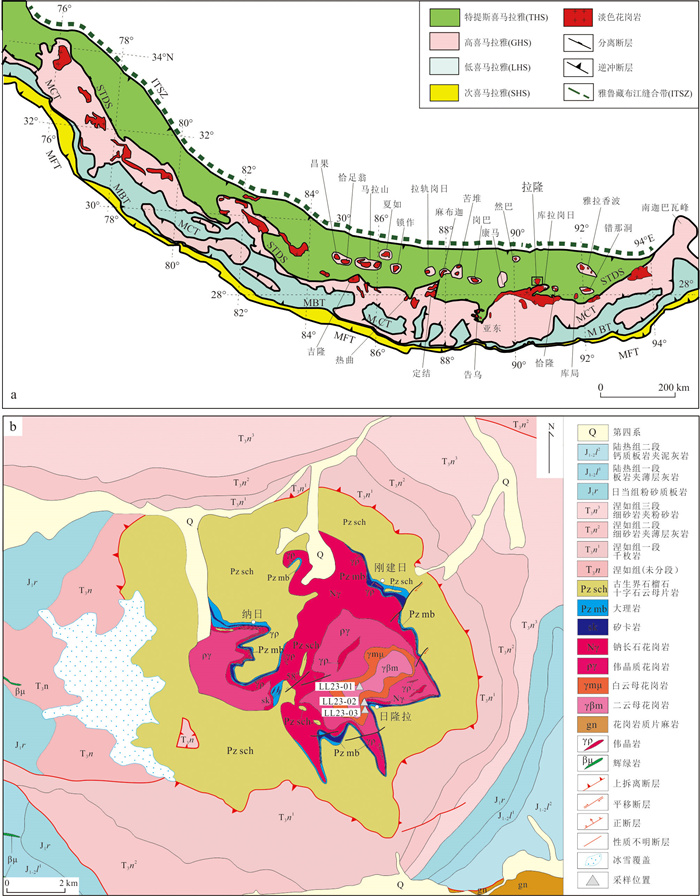
 下载:
下载:
